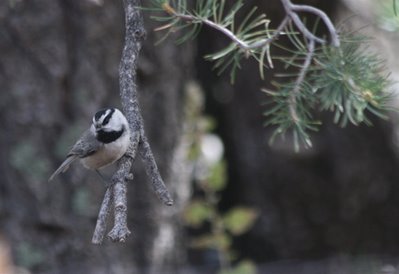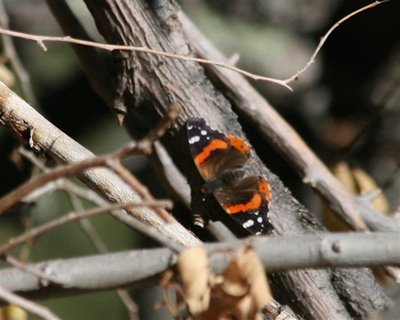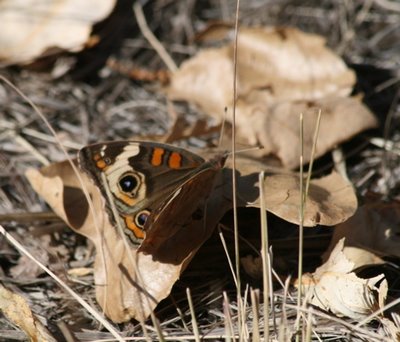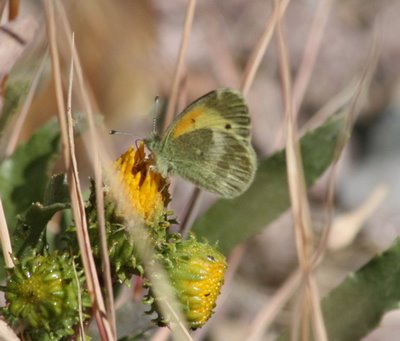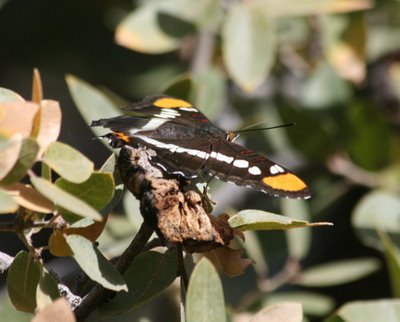Smiles of Water Canyon
One of the magic birds of the West is the bushtit, Psaltriparus minimus. It's in its own family, the Aegithalidae, and is sort of allied with verdins and kinglets. I think all those micro-birdies were just kind of thrown together; bushtits aren't much like anything else. They travel in big flocks, zipping from tree to shrub to bush to tree, and they do everything together. They're incredibly difficult to get a good look at, much less a decent picture, but some kind of scale insect held their attention long enough for me to fire off a couple of hazy shots.
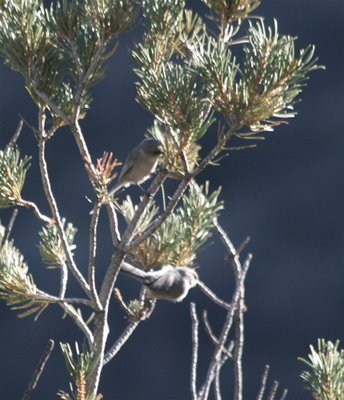
The southwestern form has kind of a masked look, and the females have pale yellow eyes, like this one.
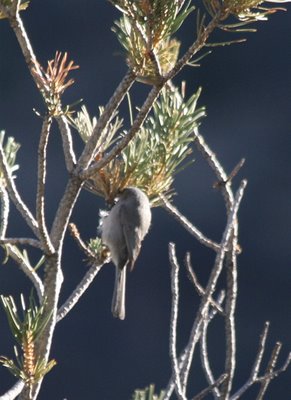 This is a 4 1/2" bird, a minibird. When they're all done feeding, they give lisping calls and explode from the tree in unison, flitting and dipping in lightning-fast flight, only to disappear into the foliage and twigs of the next. I would hate to do a study of social relationships in bushtits. Just getting a look at one is an event, much less reading color bands!
This is a 4 1/2" bird, a minibird. When they're all done feeding, they give lisping calls and explode from the tree in unison, flitting and dipping in lightning-fast flight, only to disappear into the foliage and twigs of the next. I would hate to do a study of social relationships in bushtits. Just getting a look at one is an event, much less reading color bands!Water Canyon wasn't just about birds. I scored a life mammal in this cliff chipmunk, Tamias dorsalis. It's more modestly colored than our gaudy eastern chipmunk, but a charmer nonetheless. Western chipmunks are many, and maddeningly hard to separate, but this animal showed no dorsal striping, ruling out Colorado chipmunk as a contender. I'd love to hear from anyone who disagrees with my ID. The range maps in my Kaufman mammal guide show neither species occurring in Water Canyon, but it was a chipmunk and it was there, and those are the two species whose range is closest to SW New Mexico in my book. Don't miss his shadow!
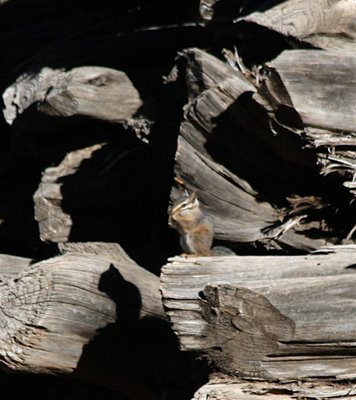
The cliff chipmunk was scurrying around in the company of a juvenile rock squirrel, Spermophilus variegatus.
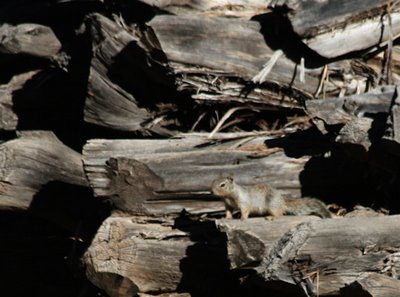
These husky squirrels look like bulked up tree-squirrels, and they flow over rocks and logs like water, being most comfortable near the ground. We'd seen them on the boulders along Monterey Bay, and in the tumbled rocks of the Chiricahuas in Arizona. They live in colonies, in burrows in the ground. Odd animals, ones for which I have no mental template: my favorite kinds!
Phoebe and Liam loved Water Canyon, and happily escorted our field trips on Saturday and Sunday. Liam made his own fun, fooling around with rocks and sticks and slidy slopes, hanging out with Phoebe and talking her ear off. They are such good traveling companions, turning to each other for fun and solace, hanging together like twin fawns behind their wandering mother and father.
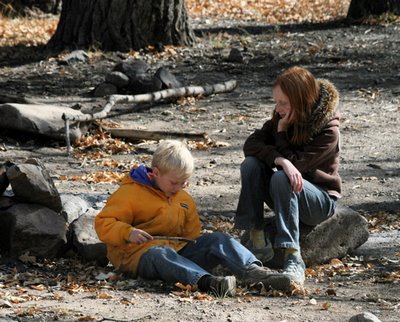 We made sure both kids got good scope looks at the birds and animals, including an Abert's squirrel--a fabulous huge tree squirrel with a silver tail, dark charcoal body and heavily tufted ears that make it look like a bunny with a fashion tail extension. I'll give you a pirated picture from New Hampshire Public Television's NatureWorks site, since ours was so distant:
We made sure both kids got good scope looks at the birds and animals, including an Abert's squirrel--a fabulous huge tree squirrel with a silver tail, dark charcoal body and heavily tufted ears that make it look like a bunny with a fashion tail extension. I'll give you a pirated picture from New Hampshire Public Television's NatureWorks site, since ours was so distant: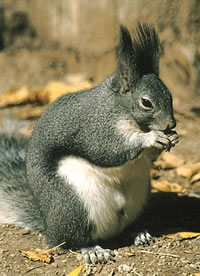 Looks like a boy. Got some squirrel junk. Ours was, too, I think, judging from the giant ear tufts. What a cutie!
Looks like a boy. Got some squirrel junk. Ours was, too, I think, judging from the giant ear tufts. What a cutie!Once we'd seen the Abert's squirrel, it was farther up the canyon to look for Williamson's sapsucker.
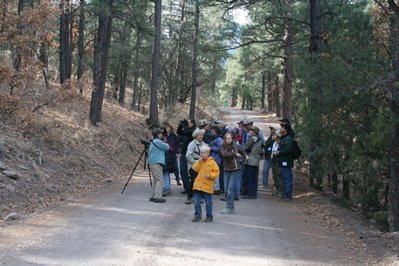 This beautiful bird has such marked sexual dimorphism that for a long time the two sexes were thought to be distinct species! The female is coal-gray and yellowish, while the male is simply splendid. I wish I had a simply splendid picture for you, but the quiet little bird hunkered down in the armpit of a ponderosa pine and sat there for an hour or so--both days we sought him out! He had a sap well there and thought he was well-hidden, but the scope gave everyone breathtaking looks, shadows or not. I had to pump this one all the way up in brightness to get any markings on it at all; it was a silhouette in the original. Dig those crazy face stripes. He's got a ruby chin, too, and a bright yellow belly. Sigh. What a bird. I've not done him justice, but at least you can get the idea.
This beautiful bird has such marked sexual dimorphism that for a long time the two sexes were thought to be distinct species! The female is coal-gray and yellowish, while the male is simply splendid. I wish I had a simply splendid picture for you, but the quiet little bird hunkered down in the armpit of a ponderosa pine and sat there for an hour or so--both days we sought him out! He had a sap well there and thought he was well-hidden, but the scope gave everyone breathtaking looks, shadows or not. I had to pump this one all the way up in brightness to get any markings on it at all; it was a silhouette in the original. Dig those crazy face stripes. He's got a ruby chin, too, and a bright yellow belly. Sigh. What a bird. I've not done him justice, but at least you can get the idea.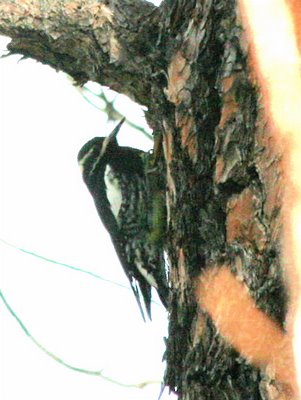
I was so proud of Bill of the Birds, patiently seeking this elusive bird, then sitting for at least an hour, waiting for it to come back around the side of the tree where he could line eager birders up on it. He shines in those situations--he's persistent and patient and most of all just wants others to see the bird. It was a lifer for many of our group, and he orchestrated a Life Bird Wiggle for the camera.
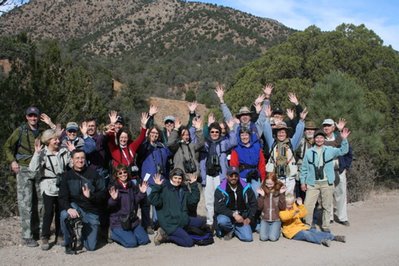
BOTB's hands stick up farther than anyone else's here. I'm snuggled into his side with a hat and tons of dorky gear hanging off me. Phoebe and Liam are on the ground, lower right. They thoroughly enjoy going on field trips with us, since birders are so kind to them (and pleasantly surprised when they prove to be troopers who hike willingly and stay quiet when they need to). Liam keeps hearts light with his antics and hilarious commentary.
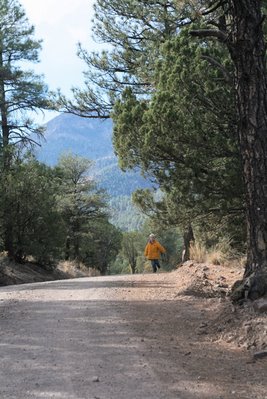 He can get dirtier than any little boy I know, faster. He seems to sit down in everything. I deserve him, since my mother despaired of keeping the seat of my pants clean. The difference is that it doesn't bother me in the least. That's what playclothes are for.
He can get dirtier than any little boy I know, faster. He seems to sit down in everything. I deserve him, since my mother despaired of keeping the seat of my pants clean. The difference is that it doesn't bother me in the least. That's what playclothes are for.Before long, we turned back down the road out of Water Canyon. The road to Magdalena beckoned. Time to go to our favorite place on the planet.
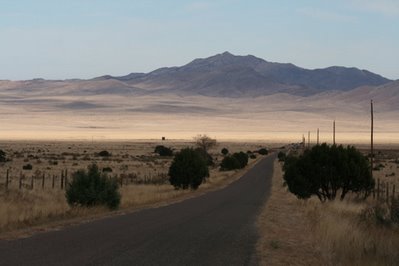 Ahhh, the magical vastness of the true American West. It's every bit as romantic and mysterious as the paperbacks and films make it out to be. Cloudshadows race across the land, chiaroscuro moods right behind them. Just back, and I miss it already.
Ahhh, the magical vastness of the true American West. It's every bit as romantic and mysterious as the paperbacks and films make it out to be. Cloudshadows race across the land, chiaroscuro moods right behind them. Just back, and I miss it already.Labels: Abert's squirrel, bushtits, cliff chipmunk, rock squirrel, Water Canyon, Williamson's sapsucker

